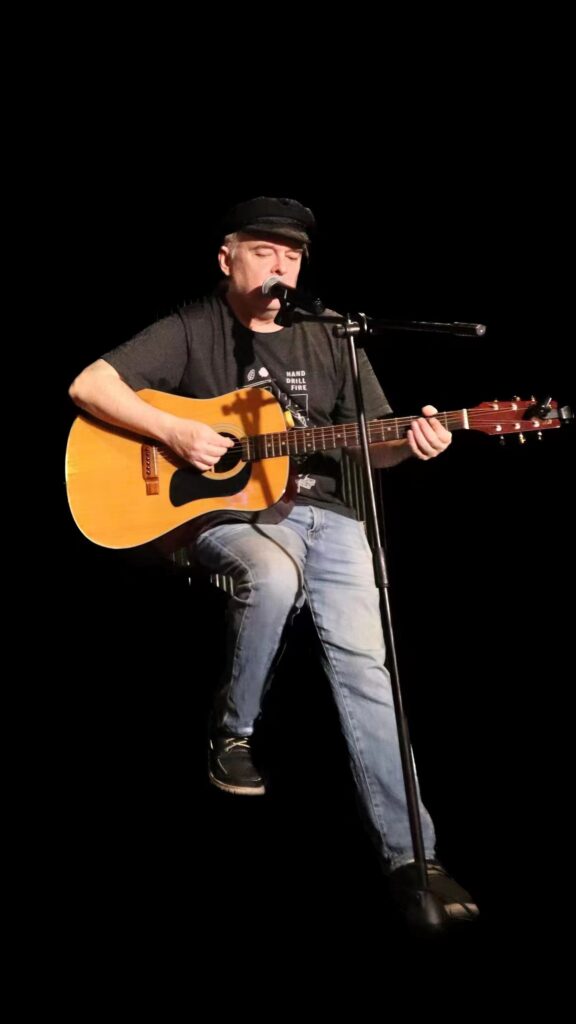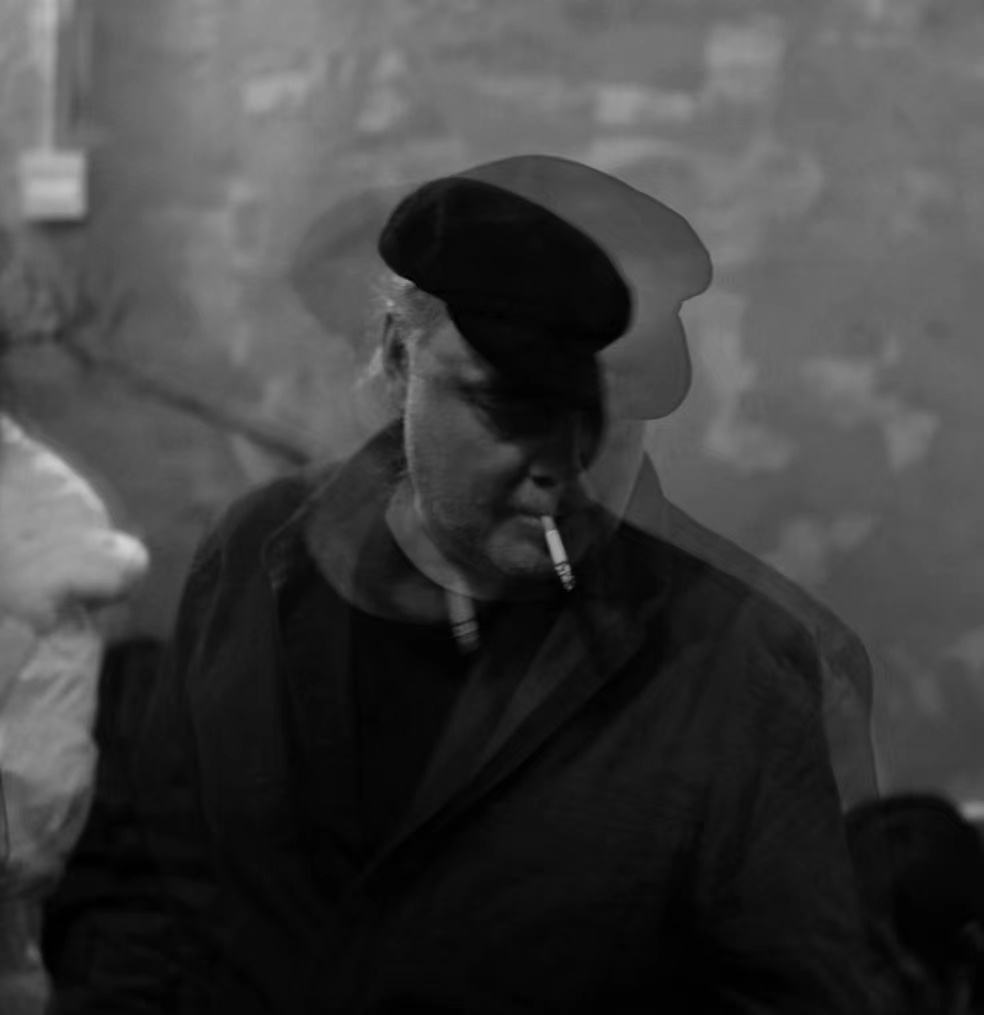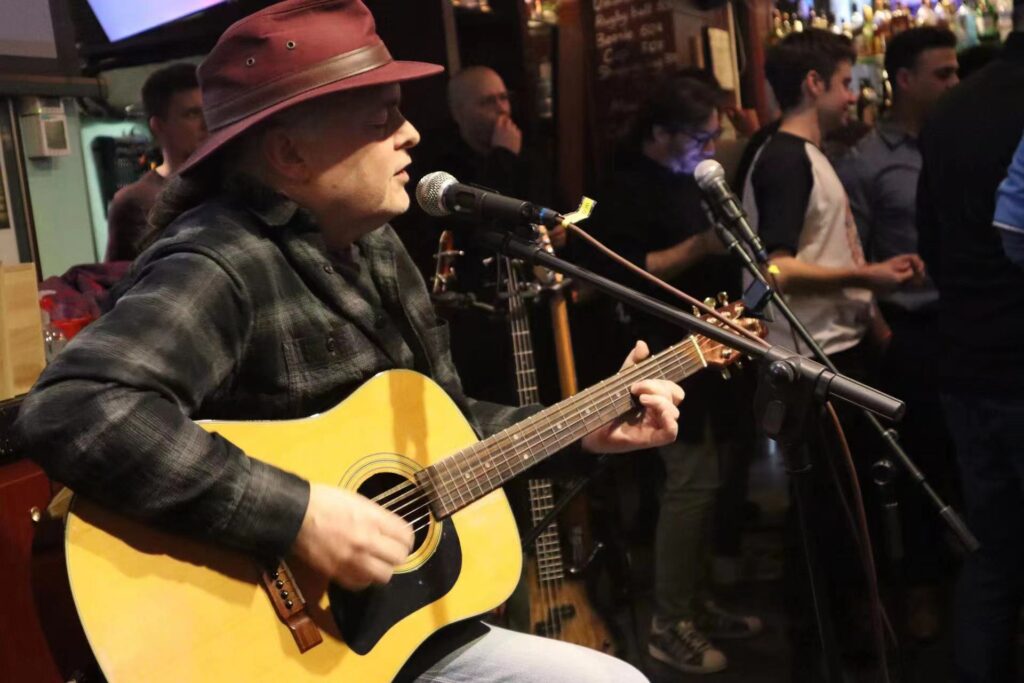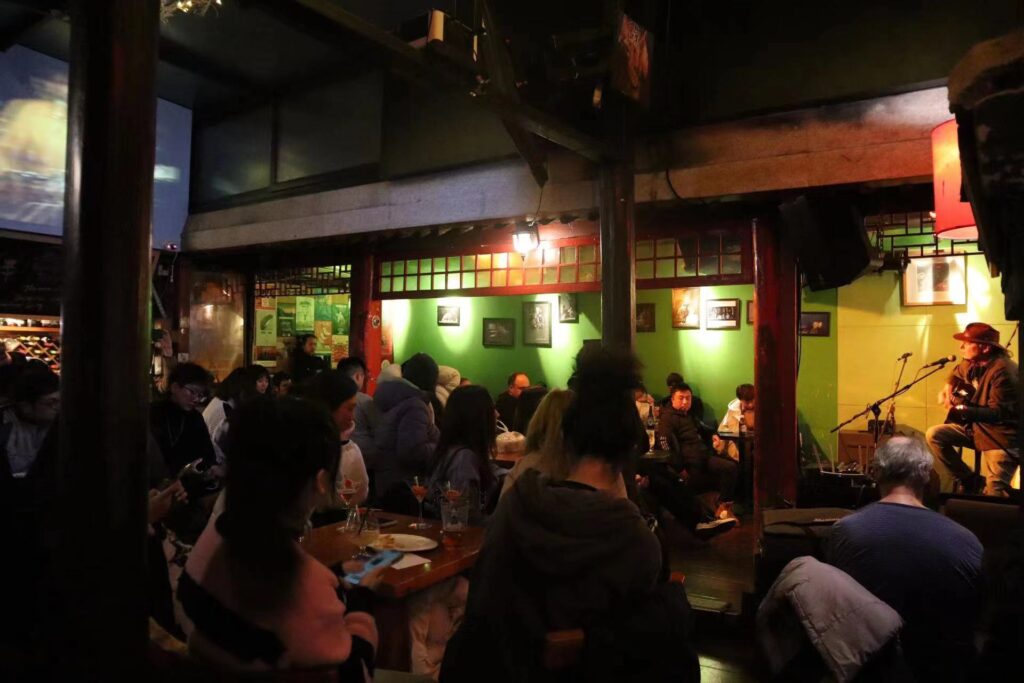Q: Hello Eric, your second album, Prowlin’ Lobo Blues, has just released. What can you tell us about it?
A: I think it is a more instrument-driven work than my 2021 album. Rhythmically, it has more of a bounce to it: The feel to me is more like waves dancing up to shore instead of a calm sea. I think it works as a unified whole and I’m happy with the track order, which is good because I thought a lot about the order. However, this means that this album requires patience to really understand and feel it as a full work. That’s ok, I can live with that.
Q: What is a Prowlin’ Lobo?
A: Well, literally a lobo is a wolf, but what we are really talking about is an unsettled being. A traveler, a seeker, a runner, a vagabond, a fugitive, a dreamer, a playboy, but all with powerful memories that continually stir a nostalgia, longing, and even guilt that perpetuate the unsettled heart.
Q: Tell us more about you, too.
A: There is alot of me in that last response. Maybe mental quiet is the only way to find a settled feeling. But then, it hasn’t happened yet, may not ever, and maybe it shouldn’t happen. Maybe this means I think too much anyway, and, of course, that’s not mental quiet. A lot of maybes. But, I think life is all maybes. So, I just prefer to ramble and make little sense to most people. I have no obligation to make sense to people, and they have no obligation to try to make sense of me. But, from any seemingly non-sensical heap of rambling maybe’s, I will find something that moves me, and that will often find its way into a verse or even a chorus, if I have a chorus. Choruses are overrated – too often used as a fall back, a hook, or a time-filler that, to me, impedes a story.

Q: The lyrics on this album are really interesting and can have a different meaning to different people, songs about departure, travelling, death, dreams…. What’s your favorite track on the album?
A: Well, I love them all. Still, I’d have to say “Penance”, “Somewhere Beyond”, and “Black Water Buff” – all solo tracks as a matter of fact.
“Penance” is a favorite because of its evolution and its uniqueness for me. Initially, I wrote “Penance” with full lyrics. But, as I developed the guitar line, I really started liking the feel of the music itself. The music seemed to live and thrive on its own. Eventually, I felt that the vocals were getting in the way of that musical life. So, I took the vocals down to a bare minimum, only keeping those that best conveyed the idea that my music may only truly be heard after I have left this world as a form of punishment for my regretful actions or inactions. The decision was something I had to really think about because I was sacrificing lyrics and instrumentals are a genre I’m not accustomed to in my music. In fact, “Penance” is the closest to an instrumental I have recorded.
“Black Water Buff” is another favorite for me. To me, this song represents a bridge between where my music has been and where I believe it is going. I wrote “Black Water Buff” as a newer, more old-timey blues version of “Terrebonne.” “Black Water Buff” is a bit John Lee Hooker influenced in style. I wanted “Black Water Buff” to be a scaled-back, straight blues, new “Terrebonne” that used only a solo acoustic guitar. I guess I wasn’t content with only the blues-rock version (“Terrebonne”), and I believe this is an insight on how the music has progressed since 2018 and the direction in which it is headed. Prowlin’ Lobo Blues contains four of the earlier songs I wrote for my blues-rock band The Eric Allen Woodshed – “Prowlin’ Lobo,” “Workin’ on the Blues,” “Terrebonne,” and “Tomcat Stroll.” They were written in 2018-19 and you could fairly call those four, more blues-rock tunes, the old-guard from this album. The new guard includes Black Water Buff and I feel that Black Water Buff is most representative of the transition, or bridge, between the old and new guard.
An honorable mention in my favorites category is “Somewhere Beyond.” I feel like the lyrics in this song can really hit home with musicians out on the road. It’s crucial that you believe inside that there are people out there who will really be moved by your music, who appreciate more than the canned pop, country, and even to some extent blues that is all too common in music these days. You must truly believe this to be able to go on fighting your way through all the people who ignore, just give empty lip service to, or just aren’t equipped to appreciate your music. This belief is the heart and soul of “Somewhere Beyond.”

Q: There are 2 kinds of songs in this album, solo songs and songs featuring other musicians. How did you choose the musicians and why?
A: Well, there must be a certain skill level – it generally needs to be high in the specific context at hand. That’s the first thing I look for. For example, Pikar Rozi has alot of experience with slap bass, something I noticed when he was playing with Hot Club of Beijing. I was looking for slap on “Moose Jaw.” Maikel Liem is very skilled with funk bass lines, which is what I thought “Workin’ on the Blues” needed to give it more drive. He also played long-term with The Amazing Insurance Salesmen and The Outstanding Vegan Bankers, which added more credibility.
That’s only the first quality I seek. I won’t choose a musician who I feel is not reliable, not patient, not open-minded, not affable, or not well-versed in a blues, or I guess country, style. I am much more picky and detailed in the studio than many may think. I need to believe that the musician will take it seriously and not take my suggestions personally if those suggestions are asking for change, additional takes, etc. I also need to be open-minded when they have suggestions for me. Skilled musicians who take it seriously often have good suggestions that I, being in the center of everything, haven’t thought of. What I don’t want is someone who comes into a sessions 15 minutes late and thinks they will just knock out their piece in a half hour without me saying a word. It never happens, regardless of their skill level. That is just not how it works. If I choose someone who ends up not meeting these criteria, I won’t record with them again in the studio on a future track of mine. So, I choose musicians based on all these qualities.
Knowing someone awhile certainly helps you know about these qualities. James Thomason, Michael Maslennikov, Greg Luttrell, and Hikmat (Binoy) Yakha are guys I have played with, traveled with, and just hung out with for years. I know these guys are top notch, open, reliable, and easy going. But it’s even more. For example, I know I can keep telling Mike in the studio to “play it with more balls” until he finally gets annoyed, plays it with more balls, and it comes out as the badass guitar line you hear in “Terrebonne.”
Sometimes, my choices of musicians are limited and that’s when things get more complicated. The pandemic meant there were fewer musicians in Beijing. For less commonly played instruments – such as the clawhammer banjo, mandolin, and horsehead fiddle – we had to record remotely. In that situation, I need to look even more based on skill level. However, personal referrals, word of mouth, and equipment and file set-up come more into play. Fortunately, the musicians who recorded remotely on this album, Tom Peng on mandolin, Dadan (Florian the Old Timer) on banjo for “Prowlin’ Lobo,” and Tamir on horsehead fiddle and throat singing for “Fire in the Canyon,” were just lights out great. These guys are top-notch. Referrals from trusted people matter. For example, Brad M. Seippel, who produced this album, referred Tamir to me, you referred Maikel Liem to me, and Kirk Kenney referred Tom Peng to me.
I was also fortunate to have a local guy, Noah Hokker, put down a trumpet line on “Workin’ on the Blues.” Noah is a fantastic trumpet player and good guy who came through Greg Luttrell. There weren’t many high-level trumpet players around at the time who had a background broader than the classical schools and could mix in those James Brown-like elements you hear on “Workin’ on the Blues.”

Q: The song “Fire in the Canyon” features Mongolian throat singing. Can you tell us what brought you to this and about the artist collaborating on the track?
A: The seeds of “Fire in the Canyon” were planted with “All on Death Row,” a song from my 2021 album. I wanted to take that mountain fiddle style that Daniel (辛欣) had played so well on “All on Death Row” and expand it into a fiddle piece with ethnic roots in China. When I toured Yunnan in the summer of 2021, I met up in Lijiang with ZhangZhi (张智) and some other fine musicians from Xinjiang Province. At the time, I thought I may integrate some Xinjiang instruments into a song or two on this album. That did not come to be, but I’m still interested in doing this later. I had “Fire in the Canyon” in my mind and I always associated it with people on horseback. So, I began thinking about Inner Mongolian sounds. It just so happened that the producer of Prowlin’ Lobo Blues, Brad M. Seippel, had collaborated with an Inner Mongolian musician named Tamir who played horsehead fiddle (马头琴). Tamir, from Hohhot, was also quite accomplished in throat singing. As soon as I heard the horsehead fiddle, I knew it was the perfect instrument for “Fire in the Canyon.” When I heard Tamir play it, I knew he was the person for this role. In my head, I had always heard this very long, kind of vocal humming for “Fire in the Canyon,” so adding throat singing seemed like a natural complement for the horsehead fiddle and a unique way to thicken the 90-second humming section in the middle of the song.
Q: A few tracks on the album are about trains. Can you tell us why?
A: I have always loved trains, older trains. There is a mystique with older trains that you don’t find with other forms of motorized transportation. Strangers eating together, sleeping together, often for several days while the landscape drifts past, calling on small, remote, towns along the way. This mystique has always been connected to the transient, non-mainstream, and historical as well. You can see it in the train songs on Prowlin’ Lobo Blues. “Itinerant Blues” is a hobo song set during the Great Depression, “Moose Jaw” is a bootlegging song set during Prohibition, and “Short Line Rag” delves into the Great Race to finish building the Transcontinental Railroad during the Reconstruction Period that followed the Civil War. The rails have played a big role throughout US history, particularly during tumultuous periods: I wanted these songs to reflect just that.

Q: Can you help us understand some of the slang used in the lyrics?
A: I probably use slang in my writing more than I realize. Slang is important. It gives a song a more natural feel. If you don’t understand the slang involved in a particular context or situation, then you should strongly consider not writing about it until you understand it better. Slang is something that puts a song on the street so to speak – to use some slang: It helps people identify with a song.
Some of my lyrics are simply an accent or dialect put down in written form, rather than actual slang. Take, for example, the phrase “She took ta yellin’ in the mornin’” from “Black Water Buff” and “Terrebonne.” Geographically, these two songs are southern-US, where you’re more likely to hear the word “started” or “began” expressed as “took ta” or took to. Another example would be the word “lord”, as in the line from these same songs “Lord my bottle, my double 4 boys I’m gonna be just fine”. I use “lord” a lot. Most of my music has roots in blues and folk, particularly from the south. Blues and folk draw much of their influence from religious hymns sang in church choirs, in the fields, on the roads, on the porches. Thus, you find a lot of references to the word “lord”, whether those references be religious in nature or more of a tool to emphasize feeling. I use it to emphasize things, but I often do it unconsciously as just a stylistic feature of my singing. It would not be a part of any lyrics that I initially write. It just comes out naturally when I sing, and then gets added into the lyric transcriptions later.
I love slang – it is a form of creative and historical expression, similar in my mind to graffiti. A good slang phrase is actually a song title on this album – black water buff. Louisiana, of course, has a lot of swamp land, because its elevation is at, or sometimes below, sea level. Swamp water tends to take on darker colors with the oversaturation of the land. So, you hear swamps referred as black water. Aligators and crocodiles inhabit swamps. They’re big and strong, much like buffalos, which are excellent swimmers, too. Thus, some refer to swamp aligators as black water buffs. Another example is a “roscoe burner,” also referred to in “Black Water Buff” and “Terrebonne.” This is an older slang term for a handgun, often a snub-nosed revolver.
“Workin’ on the Blues” also uses slang. “Southside Johnnys” and “chain-gang” come to mind. A cultural reference, by Southside Johnnys I am referring to somewhat successful street hustlers from a bygone era on the south side of Chicago (shorthand slang for Chicago is Chi-town) who were well-dressed in colorful attire. A chain gang is a term used to describe inmate work teams in prison. I worked in a federal prison for a few years in the 1990s and heard this term being used metaphorically quite a bit. It’s a commonly used expression that started probably in the 19th century to describe a group of men being forced to work while being bound together on a long metal chain, rope, etc.
Another good example is found in “Moose Jaw” – track 5 from the album. Consider the final verse “Yonder come / See the Soo a comin’ / Pulling into Moose Jaw / Get the rum ta runnin’ / Haul it down south where it’s dry as a bone / So the hounds can all come stumblin’ home.” “Yonder come” is a southern phrase meaning something is coming. This phrase was in my head from the beginning. It was the first lyrics I wrote for “Moose Jaw,” and along with Mississippi John Hurt’s version of “Spike Driver Blues” that he played on Pete Seeger’s television show, it really formed the nucleus of this song. The Soo Line was a train line that operated between Chicago and Moose Jaw, Canada during Prohibition. It still operates, but no longer provides passenger service to my knowledge. “Rum runner” is a phrase often used in relation to pirate bootleggers on the sea – – poetic license. “Dry as a bone” – well, this was during Prohibition when liquor was banned. “Hounds can all come stumblin’ home.” This comes from a slang term for drunks – boozehounds.

Q: This time you have one music video per track. Can you tell us more about the different directors?
A: I worked with a group of directors in creating the 13 videos. It’s no small task. All the footage was shot by Graeme Nicol back in the summer 2022 at a few different locations, which focused on now defunct railroad tracks. Graeme, who is Scottish, directed the editing on 5 videos: “Itinerant Blues,” “Moose Jaw,” “Somewhere Beyond,” “Fire in the Canyon,” and “Tomcat Stroll.” Graeme is a deliberate, fairly quiet guy – a thinker who is full of great ideas.
Michael Maslennikov directed the video editing for “Prowlin’ Lobo” and “Terrebonne.” Mike has played lead guitar in my band the Eric Allen Woodshed since 2018, and is also a music photographer and videographer. Mike directed the videos for “40 Years,” “Hello My Soul,” and “Road Travels On” from my first album in 2021. From Russia, he is as reliable and solid as they come and develops fabulous guitar lines that are characterized by a nice melding of solo riffs with very cool rhythms.
A leading figure in China’s music scene for many years now, a French fellow named Djang San, directed the video editing for track 8 on the album, “Short Line Rag” – that’s you. This guy does interviews – among seemingly a million other very cool musical projects such as albums, videos, collaborations with ethnic orchestras, documentaries, instrument construction, etc., etc. I’m waiting for the full-length novel.
The third track on the album, “Black Water Buff,” was directed by Nina Dillenze. I first met Nina in 2019 when we collaborated on a poetry and music project for a Beijing music and poetry organization called Spittunes. Nina, who is from Vienna, Austria, often uses nature, silent film, pop culture, and psychedelia as focal points in her creative projects, which mainly revolve around live visuals and videography. She has directed and edited a variety of musical videos for Austrian and Chinese artists. I guess Nina can add American artists and railroad tracks to that list.
Then, there is me. I directed, if that’s what you want to call it, the videos for four tracks: “Workin’ on the Blues,” “Penance,” “Ball in the Street,” and “Free Blue.” Unlike the other 9 videos on the album, these videos came from personal footage and from footage taken by friends in the US, including Robert “Money Bags” Albright, Micah “McKruger” McCauley (Go Ball State Cardinals!), Eric Johnson, David Pearson, and my sister Marcela “Bella Odella” Laurenze. Another American friend, Thomas McKibben, who I shared many a brew with at Steve Goodey’s and Peter Hogg’s Ossie Bar in Beijing, took a video of a stream in Sichuan Province, China that serves as the anchor scene in “Penance.” The video for “Ball in the Street” basically fell into my lap. My lifelong friend from Indiana, Eric Johnson, sends me videos from time to time. They are mostly dashcam videos of him driving the highways and rural roads of central Indiana. Unplanned, he sent a driving video that instantly made me hear “Ball in the Street” in my head. I knew it was the perfect match for that song and that’s what you see today.

Q: What do you want to show through these videos?
A: Not much. I just want them to be good quality, interesting, and match the pace and feel of the song. I don’t really care for videos. For me, they distract from the music and can carry too much weight in determining a person’s feelings about a song. Just give me the audio and I’m fine. Still, that’s the old school purist in me talking, and certainly we live in a visual-driven world where many people’s musical experience is enhanced by video. So, I wanted to take the challenge of making a video for all 13 tracks on this album and see what I could learn from doing that: I definitely learned a lot, too. Learned about file terminology, large file transfer, the videography and editing itself, and working with visual creative artists (I’m used to working with creative artists in a more audio setting). It’s been worth the ride, and the final product has far exceeded what I imagined. Big kudos to all the video directors on Prowlin’ Lobo Blues!
Q: What are your plans with the album?
A: To promote it as much as possible both online and live. To get the music noticed – that’s a tough proposition in the world today. I only make music that I believe in. I hope others can see the value in that music.
Q: What are your plans for the future?
A: I’ve got a lot of rhythms recorded at home. A lot of grainy, dirty, totally unpolished rhythms that I can probably only half-assed play right now. A few songs are complete, but it’s mostly rhythmic ideas now without lyrics. I’ll turn to these soon and we’ll see what comes from it. But, as I mentioned before, the “Terrebonne” / “Black Water Buff” bridge is built, and I anticipate crossing it on the next album.

Streaming Link
https://verseone.ffm.to/9vr9j3e
Spotify Streaming Link
https://open.spotify.com/album/7px3JrLGzXRk32KMTeSwY8?si=2Cnl9gXzQSmvHEVgUwbvLw
Deezer Streaming Link
https://www.deezer.com/us/album/372341957?deferredFl=1
1st album – https://ericallenmusic.bandcamp.com/album/eric-allen
